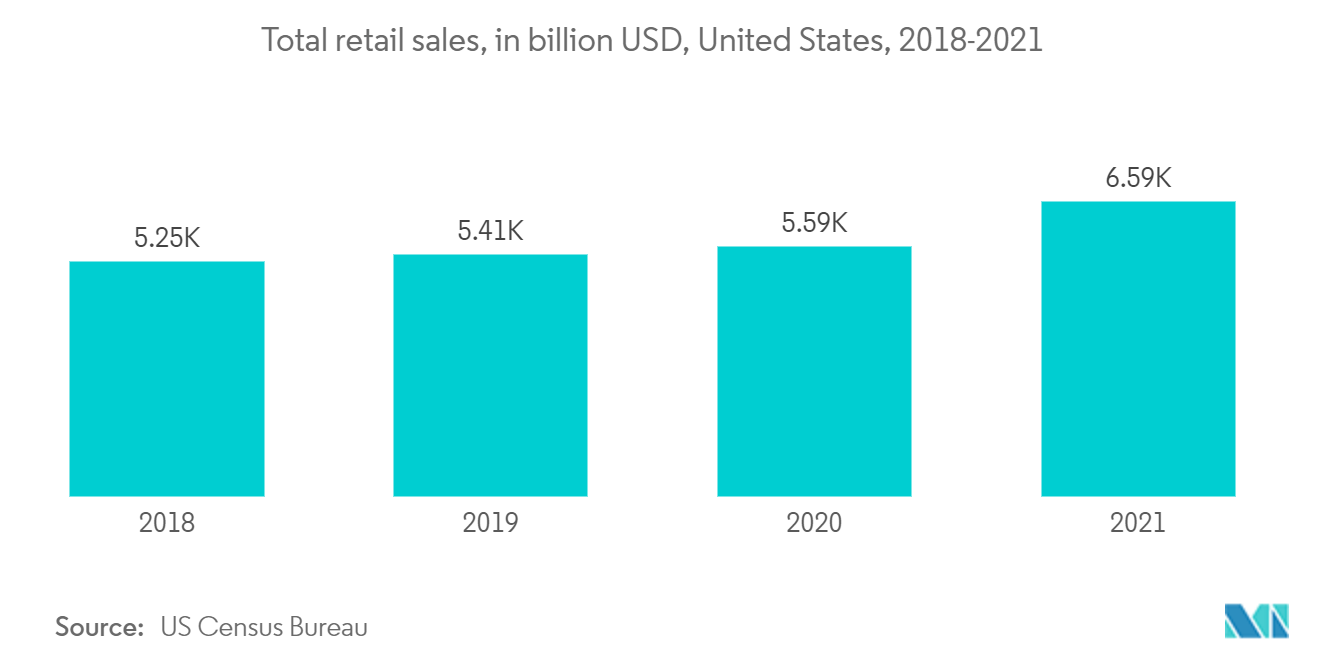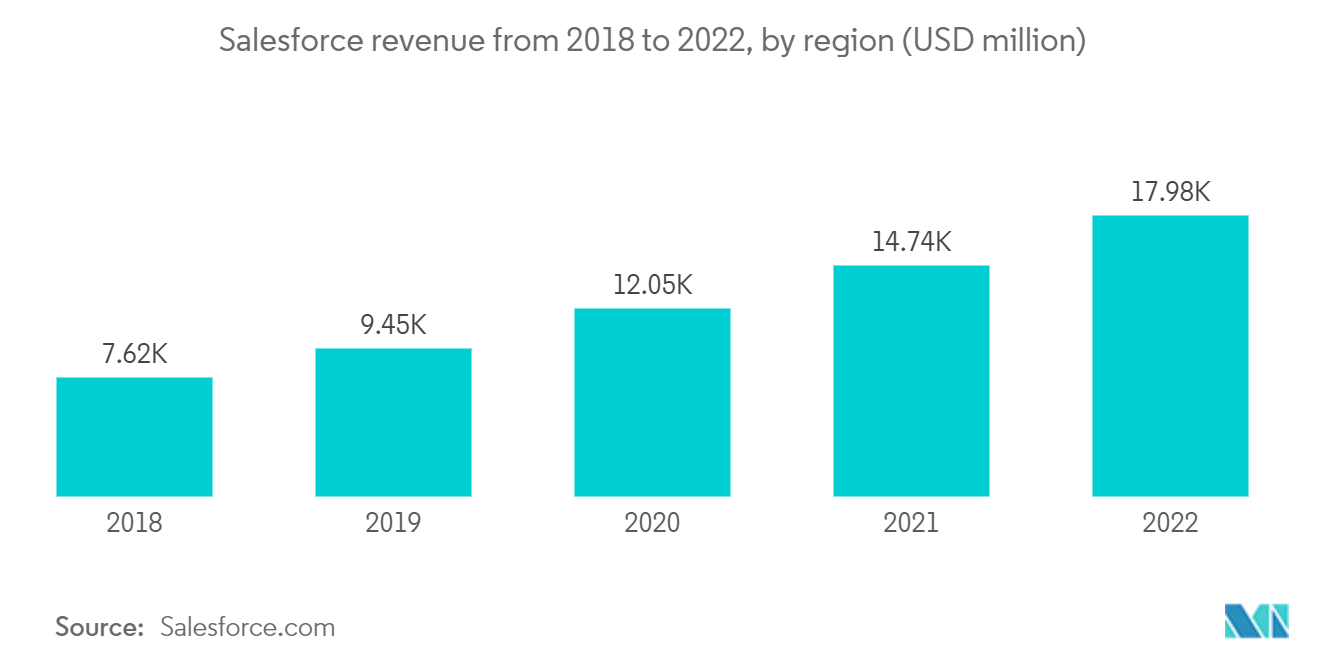Market Trends of CRM Analytics Industry
This section covers the major market trends shaping the CRM Analytics Market according to our research experts:
Retail Industry is Expected to Drive the Market's Growth
- The market for CRM analytics is expected to expand as a result of the investments made by various companies in the rapidly expanding retail industry. For instance, IBEF reports that India sees a boom in the number of retail technology companies that provide the retail industry with services like digital ledgers, inventory management, payment options, and tools for logistics and fulfillment.
- Making smarter decisions that lead to greater earnings, higher customer satisfaction, and a keener shop overall is possible by relying on retail analytics and hard facts rather than conjecture. According to a poll of over 350 retailers and brand manufacturers conducted by Alteryx and RetailWire, 81% of respondents said they obtain shopper insights, and 76% believe that insights are essential to their business. Unfortunately, while many retailers get data, most don't do anything with it. Only 16% of respondents to the poll said they were "experts" at exploiting data, while 24% and 60%, respectively, said they were "newbies" and "getting there."
- The one factor that determines who succeeds and fails in the retail industry in today's electronically interconnected global village, where consumer behavior is greatly influenced by the power of social media and mobile, is the ability to attract and hold consumers' attention. CRM analytics in retail give stores a way to learn about their customers' buying habits and deliver personalized service based on their preferences. This is good for both the store and the customer.
- In order to provide customers with the greatest products and experiences, many retail chains are attempting to increase customer happiness by employing artificial intelligence (AI) tools like machine learning and computer vision to research consumer behavior online and in real locations. For instance, in January last year, a multi-brand retail chain owned by Aditya Birla Fashion and Retail Ltd. called Pantaloons implemented an AI-based decision engine dubbed Xen AI by Algonomy, an AI solutions vendor with offices in Bengaluru and San Francisco. Xen AI chooses the best experience for each interaction in real-time based on the customer's profile and place in the purchasing process. A salesperson could use an app to help a woman who looks for a peach dress online and then comes to the store to try it on based on her preferences, search history, and what she has bought before.
- New players have been adopting the e-commerce business model to benefit from increasing smartphone usage. Thus, the vendors in the market have been exposed to opportunities to expand their client base. Additionally, several retailers have taken a hands-on approach to customer data to predict patterns and derive insights when combined with other data assets. As a result, these companies have been combining consumer insight with location data (GIS) to gain a new understanding of where and how people shop.
- Further, omnichannel retailers have been guiding the development of the segmentation of their customer base into core shopper profiles to cater to where and how each segment behaves. By using location data and artificial intelligence to pinpoint the dollar value of a physical store, retailers have benefited from increased online sales in that geographic region. These insights are made possible by the convergence of two technologies: customer relationship management (CRM) and geographic information system (GIS) software. At the same time, the analytics part takes care of timely statistical findings.

North America is Expected to Hold a Major Market Share
- North America is a major contributor to the global CRM analytics market. This is mainly due to growth in the data and increased awareness about retaining valuable customers. Growing industries such as BFSI, telecommunications and IT, healthcare and life sciences, transportation, and logistics are fueling the global CRM analytics market's growth.
- Technological development is further driving the market in the forecasted period. For instance, in April last year, with new enhancements that display AI-powered, practical insights in the workflow, Salesforce released CRM Analytics. Further, to provide more individualized customer experiences, these technologies assist sales executives, service leaders, and staff members across many industries, including financial services, manufacturing, consumer products, and communications.
- The implementation of data-driven decision-making is also rising in Canadian markets across various sectors. Cloud business management solutions vendor Sage launched its cloud-first Sage Data and Analytics service integration for Sage 300 and Sage 100 in the US and Canadian markets in March 2021. With the help of AI and machine learning algorithms, its business intelligence toolkit can provide users with live sales dashboards and detailed P&L reports.
- In April last year, in order to provide a unified revenue management command center that provides sales leaders with insights throughout the sales and revenue cycles, Salesforce unveiled Revenue Intelligence, bringing Sales Cloud and CRM Analytics together. With revenue intelligence, teams have deeper visibility into how their forecast is changing over time and AI-led insights on deals that are more likely to convert.
- Predominantly, there are two ways in which AI-driven business intelligence software could bring value to banks and financial institutions, including investment firms. These include report generation and predictive analytics. For instance, SAS Visual Analytics, a United States-based firm, claims to help banks provide their lead staff with self-service analytics and interactive reports using a combination of predictive analytics and natural language processing. For banks, this analysis and reporting are related to customer buying patterns, loan payments, or customer experience. Such software applications can help BFSI institutions develop strategies for gaining customers or finding customers less likely to default on loans.


